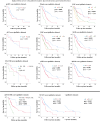Applicability of scoring systems predicting outcome of transarterial chemoembolization for hepatocellular carcinoma
- PMID: 32107625
- PMCID: PMC7085483
- DOI: 10.1007/s00432-020-03135-8
Applicability of scoring systems predicting outcome of transarterial chemoembolization for hepatocellular carcinoma
Abstract
Purpose: Several scoring systems have been proposed to predict the outcome of transarterial chemoembolization (TACE) in patients with hepatocellular carcinoma (HCC). However, the application of these scores to a bridging to transplant setting is poorly validated. Evaluation of the applicability of prognostic scores for patients undergoing TACE in palliative intention vs. bridging therapy to liver transplantation (LT) is necessary.
Methods: Between 2008 and 2017, 148 patients with HCC received 492 completed TACE procedures (158 for bridging to transplant; 334 TACE procedures in palliative treatment intention at our center and were analyzed retrospectively. Scores (ART, CLIP, ALBI, APRI, SNACOR, HAP, STATE score, Child-Pugh, MELD, Okuda and BCLC) were calculated and evaluated for prediction of overall survival. ROC analysis was performed to assess prediction of 3-year survival and treatment discontinuation.
Results: In patients receiving TACE in palliative intention most scores predicted OS in univariate analysis but only mSNACOR score (p = 0.006), State score (p < 0.001) and Child-Pugh score (p < 0.001) revealed statistical significance in the multivariate analysis. In the bridging to LT cohort only the BCLC score revealed statistical significance (p = 0.002).
Conclusions: Clinical usability of suggested scoring systems for TACE might be limited depending on the individual patient cohorts and the indication. Especially in patients receiving TACE as bridging to LT none of the scores showed sufficiently applicability. In our study Child-Pugh score, STATE score and mSNACOR score showed the best performance assessing OS in patients with TACE as palliative therapy.
Keywords: Embolization; Liver cancer; Stage migration; TACE.
Conflict of interest statement
All authors declare that there is no conflict of interest.
Figures
References
-
- Abbasi AH, Abid S, Haq TU, Awan S (2017) Role of assessment for retreatment with transarterial chemoembolization score in decision of retreatment with trans-arterial chemo-embolization Sessions in patients with hepatocellular carcinoma. J Ayub Med Coll Abbottabad 29:378–383 - PubMed
-
- Allgaier HP, Deibert P, Olschewski M, Spamer C, Blum U, Gerok W, Blum HE (1998) Survival benefit of patients with inoperable hepatocellular carcinoma treated by a combination of transarterial chemoembolization and percutaneous ethanol injection—a single-center analysis including 132 patients. Int J Cancer 79:601–605 - PubMed
-
- Arii S et al (2000) Results of surgical and nonsurgical treatment for small-sized hepatocellular carcinomas: a retrospective and nationwide survey in Japan. Liver Cancer Study Group Jpn Hepatol 32:1224–1229. 10.1053/jhep.2000.20456 - PubMed
-
- Brown DB, Fundakowski CE, Lisker-Melman M, Crippin JS, Pilgram TK, Chapman W, Darcy MD (2004) Comparison of MELD and Child-Pugh scores to predict survival after chemoembolization for hepatocellular carcinoma. J Vasc Interv Radiol 15:1209–1218. 10.1097/01.rvi.0000128123.04554.c1 - PubMed
MeSH terms
Substances
LinkOut - more resources
Full Text Sources
Medical
Miscellaneous






